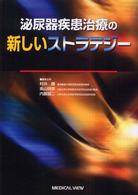- ホーム
- > 洋書
- > 英文書
- > Science / Mathematics
Full Description
Recently, a great deal of effort has been dedicated to capitalising on advances in mathematical control theory in conjunction with tried-and-tested classical control structures particularly with regard to the enhanced robustness and tighter control of modern PID controllers. Much of the research in this field and that of the operational autonomy of PID controllers has already been translated into useful new functions for industrial controllers. This book covers the important knowledge relating to the background, application, and design of, and advances in PID controllers in a unified and comprehensive treatment including:
Evolution and components of PID controllers
Classical and Modern PID controller design
Automatic Tuning
Multi-loop Control
Practical issues concerned with PID control
The book is intended to be useful to a wide spectrum of readers interested in PID control ranging from practising technicians and engineers to graduate and undergraduate students.
Contents
1. Introduction.- 1.1 Evolution of the PID Controller.- 1.2 Components of the PID Controller.- 1.3 Choice of Controller Type.- 1.4 Nomenclature of the PID Controller.- 1.5 Structures of the PID Controller.- 2. Classical Designs.- 2.1 Introduction.- 2.2 Design Objectives - Speed Versus Stability.- 2.3 Trial and Error Method.- 2.4 The Ziegler-Nichols Methods.- 2.5 The Stability Limit Method.- 2.6 The Cohen-Coon Method.- 2.7 The Tyreus-Luyben Method.- 3. Modern Designs.- 3.1 Introduction.- 3.2 Constraints of Classical PID Control.- 3.3 Pole Placement Design.- 3.4 Dominant Pole Placement.- 3.5 Gain and Phase Margin Design I: PI Controller.- 3.6 Gain and Phase Margin Design II: PID Controller.- 3.7 Linear Quadratic Control Design.- 3.8 Composite PI-Adaptive Control Design.- 4. Automatic Tuning.- 4.1 Introduction.- 4.2 Step Response Approach.- 4.3 Relay Feedback Approach.- 4.4 On-line Relay Tuning.- 4.5 FFT on Relay Transients.- 4.6 Frequency Response - Transfer Function Conversion.- 4.7 Continuous Self-Tuning of PID Control.- 5. Multi-loop Control.- 5.1 Introduction.- 5.2 The Modified Ziegler-Nichols Method.- 5.3 Review of the BLT (Biggest Log-Modulus Tuning).- 5.4 Modified Ziegler-Nichols Method for Multi-Loop Processes.- 5.5 Derivation of the Design Equations.- 5.6 Simulation study.- 5.7 Extension to Cross-coupled Controllers.- 6. Practical Issues.- 6.1 Introduction.- 6.2 Non-linearities.- 6.3 Disturbances.- 6.4 Operational Aspects.- 6.5 Digital PID Implementation.- A. Industrial Controllers.- A.l ABB COMMANDER 351.- A.2 Elsag Bailey Protonic 500/550.- A.3 Foxboro 718PL/PR.- A.4 Honeywell UDC3300.- References.








